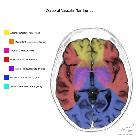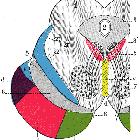basilar artery


Cerebral
angiography, injection in the left vertebral artery, with retrograde flow in the contralateral vertebral artery, the basilar artery and the posterior communicating artery. The posterior cerebral circulation can be seen, including the posterior part of the Circle of Willis.

Anterior
cerebral artery • Common variants of the circle of Willis (illustrations) - Ganzer Fall bei Radiopaedia

Circle of
Willis • Vertebrobasilar angiography - Ganzer Fall bei Radiopaedia

Middle
cerebral artery (MCA) infarct • Cerebral vascular territories (illustration) - Ganzer Fall bei Radiopaedia

Basilar
artery • Basilar tip aneurysm - Ganzer Fall bei Radiopaedia

Vertebral
artery • Vertebral artery - Ganzer Fall bei Radiopaedia

Anterior
inferior cerebellar artery • Brainstem arterial territories (diagrams) - Ganzer Fall bei Radiopaedia

Schematic
representation of the circle of Willis, arteries of the brain and brain stem. Feel free to improve (edit) this representation!
The basilar artery is part of the posterior cerebral circulation. It arises from the confluence of the left and right vertebral arteries at the base of the pons as they rise towards the base of the brain.
Summary
- origin: vertebral artery confluence
- course: ventral to pons in the pontine cistern
- branches: numerous to cerebellum and pons
- termination: division into the two posterior cerebral arteries
- variants: basilar artery fenestration; persistent carotid-basilar artery anastomoses
Gross anatomy
Course
The basilar artery runs cranially in the central groove of the pons towards the midbrain within the pontine cistern. It travels within this groove from the lower pontine border adjacent to the exit of the abducens nerve to the upper pontine border and the appearance of the oculomotor nerve. It bifurcates at the upper pontine border.
Branches
Before terminating at the upper pontine border where it divides into the two posterior cerebral arteries, it provides several paired branches:
- anterior inferior cerebellar artery (AICA)
- labyrinthine artery (variable origin; more commonly a branch of AICA)
- pontine arteries
- superior cerebellar artery (SCA)
Variant anatomy
Related pathology
Siehe auch:
- Cerebellum
- Arteria vertebralis
- Pons
- fenestrierte Arteria basilaris
- Basilaristhrombose
- Arteria cerebri posterior
- Circulus Willisi
- Mesencephalon
- posterior cerebral circulation
- Arteria cerebelli superior
- labyrinthine artery
- persistierende karotidobasiläre Anastomosen
- pontine cistern
- Arteria cerebelli anterior inferior
- pontine arteries
- top of the basilar artery syndrome
und weiter:

 Assoziationen und Differentialdiagnosen zu Arteria basilaris:
Assoziationen und Differentialdiagnosen zu Arteria basilaris:










